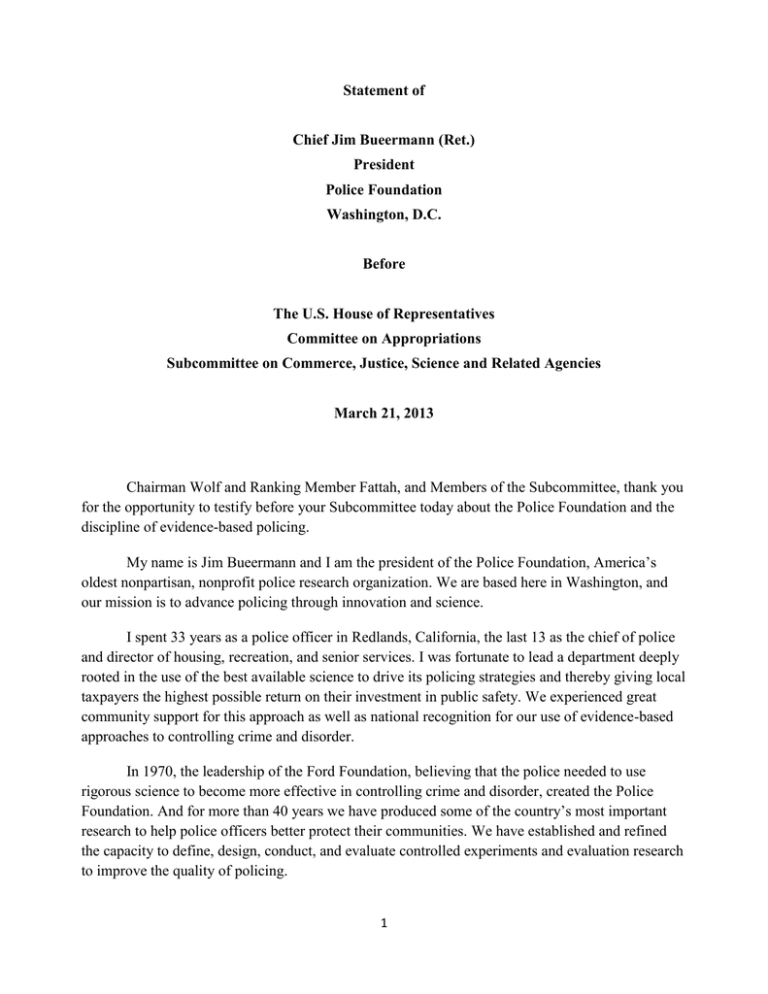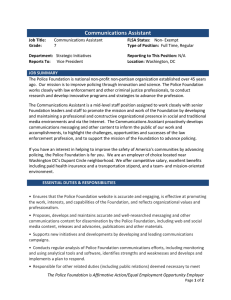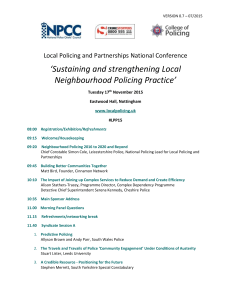Statement of Chief Jim Bueermann (Ret.) President
advertisement

Statement of Chief Jim Bueermann (Ret.) President Police Foundation Washington, D.C. Before The U.S. House of Representatives Committee on Appropriations Subcommittee on Commerce, Justice, Science and Related Agencies March 21, 2013 Chairman Wolf and Ranking Member Fattah, and Members of the Subcommittee, thank you for the opportunity to testify before your Subcommittee today about the Police Foundation and the discipline of evidence-based policing. My name is Jim Bueermann and I am the president of the Police Foundation, America’s oldest nonpartisan, nonprofit police research organization. We are based here in Washington, and our mission is to advance policing through innovation and science. I spent 33 years as a police officer in Redlands, California, the last 13 as the chief of police and director of housing, recreation, and senior services. I was fortunate to lead a department deeply rooted in the use of the best available science to drive its policing strategies and thereby giving local taxpayers the highest possible return on their investment in public safety. We experienced great community support for this approach as well as national recognition for our use of evidence-based approaches to controlling crime and disorder. In 1970, the leadership of the Ford Foundation, believing that the police needed to use rigorous science to become more effective in controlling crime and disorder, created the Police Foundation. And for more than 40 years we have produced some of the country’s most important research to help police officers better protect their communities. We have established and refined the capacity to define, design, conduct, and evaluate controlled experiments and evaluation research to improve the quality of policing. 1 Our goals are twofold. First, we conduct rigorous scientific research that produces relevant results that can be directly applied to policing policy or practice. Our research is designed to address the questions, challenges, and problems faced by contemporary policing agencies. Second, we act as a translational agent to move existing research from theory into practice. We strive to translate the larger world of scientific research into actionable information for law enforcement leaders and policy makers. As your Subcommittee provides funding for law enforcement support and research programs in the Department of Justice, my purpose today is to share with you some of our thinking on emerging national issues. I am not here seeking funding for the Police Foundation, but I would like to extend an invitation to the Members and staff of the Subcommittee to use us a resource as you develop and fund policing research programs in the future. Decreases in local funding for public safety mean that local governments cannot support an ever-increasing number of police officers — or, in many cases, even the status quo. Therefore, police chiefs and sheriffs must shift their attention to more efficient and effective strategies, generated from well-designed scientific examination of what works to control crime and disorder. That model is called evidence-based policing (EBP), and it represents the field’s most powerful force for change. Evidence-based policing offers a practical solution to the challenge of balancing public safety, available funds, and taxpayer expectations. It blends the science of controlling crime and disorder with the principles of community policing and problem solving. It helps communities focus on meaningful, achievable, and measureable public safety outcomes. It can be implemented without straining budgets, disrupting police organizations, or offending community members. And it can help police departments strengthen their legitimacy with the communities they serve. The following are just a few examples of the areas in which we believe greater policerelated research is justified: • the role of the police in helping prevent mental health related gun violence; • policing on school campuses; • police legitimacy; • policing and prisoner reentry and drug courts; • the role of the police in wrongful convictions; • officer safety and wellness; • preventable error in policing; 2 • police use of unmanned aerial vehicles; • mobile device technologies; and • additive manufacturing and the use of so called “3D printers.” As the Subcommittee develops future legislation, I urge you to investigate, promote, and enhance the use of evidence-based policing research and strategies. I thank all the Members of the Subcommittee for allowing me this opportunity to testify today about the Foundation and how its work can leverage taxpayer investments to improve public safety outcomes. I thank you for your service to our great nation. 3







